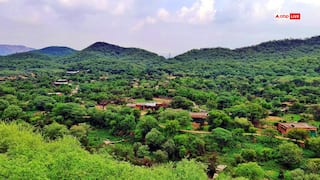What Happens After Black Hole Images Are Captured? Here Is What Scientists Do With Them
Black Hole Image: The International Event Horizon Telescope Collaboration, after mobilising more than 300 scientists and engineers, captured the first-ever images of supermassive black holes

New Delhi: The international Event Horizon Telescope collaboration has captured a second image of the black hole. This time, the black hole at the centre of our own Milky Way galaxy has been imaged. However, to give the image meaning, the collaboration had to compare the photograph with black hole simulations.
The International Event Horizon Telescope Collaboration, after mobilising more than 300 scientists and engineers to establish a network of synchronised telescopes that form an Earth-sized virtual telescope, captured the first-ever images of supermassive black holes. The first image of a black hole was released in 2019. It was an image of the black hole at the centre of the Messier 87 galaxy. The latest image of a black hole was released on May 12, 2022. The image is that of the black hole at the centre of the Milky Way galaxy, called Sagittarius A*.
What happens After Black Hole Images Are Captured?
Chi-Kwan "CK" Chan, a University of Arizona associate research professor, said in a statement issued by the university that "snapping an image is just the beginning". He added that to really understand the object researchers were observing, they had to compare it to simulations.
Chan is a leader of the EHT Collaboration's theoretical modelling and interpretation efforts for Sagittarius A*, which is the subject of the latest photograph and a number of scientific papers published by the EHT Collaboration in the Astrophysical Journal Letters. The fifth paper focuses on creating black hole simulations and turning them into synthetic images that can be compared with real observations to teach the world something new about black holes.
The EHT scientists, as a result of the process, determined that Sagittarius A* is likely spinning and has a magnetic field slightly stronger than a refrigerator magnet, which is enough to push away nearby gas, the statement said.
The gas which falls into the black hole forms a disc. From Earth, the disc appears to be face-on rather than from the edge. This is known as the accretion disk. It is made up of superheated gas, or plasma, and charged particles, with the electrons being 100 times cooler than the ions in the plasma.
The accretion disk rotates in the same direction the black hole spins. Only some of the material falls into the black hole. This means that if Sagittarius A* were a person, it would consume a single grain of rice every million years.
How Do Scientists Find Meaning In The Images?
University of Arizona, together with the University of Illinois and Harvard University in the United States, led the effort to create the biggest collection of simulations to date. This collection, called the simulation library, is made up of thousands of data sets, containing information about how the plasma interacts with magnetic fields around black holes, and millions of simulated images. According to the statement, each simulation assumes something different about the properties and characteristics of a black hole and its surroundings.
Each simulated image can be compared with the actual black hole image to find a match. The simulation that creates the snapshot with the closest match can teach people something about the actual black hole image, including its plasma temperature and the strength of its magnetic field.
What Does The Simulation Process Involve?
During the simulation process, supercomputers are used to solve what are called general relativistic magnetohydrodynamic, or GRMHD equations. They reveal the movement of energy and material around black holes within dramatically warped space and time. Chan said that GRMHD simulations are similar to simulations used to understand how air flows around aircraft. The GRMHD simulations also factor in extreme forces of gravity as described by Einstein's theory of general relativity, and the interaction between magnetic fields and plasma.
What Are GRMHD Equations?
GRMHD equations, unlike simple equations which can be solved with pencil, paper, and time, are much more complex. This is because they account for the constant feedback between magnetic fields and plasma, resulting in an ever-changing equation.
How Was The Simulation Library Created?
The EHT Collaboration needed 80 million CPU hours or processing time in order to create the simulation library. The processing time is the equivalent of running 2,000 laptops at full speed for a full year. Then, the collaboration ran the calculations to create the library with the National Science Foundation-funded Frontera supercomputer at the Texas Advanced Computing Center in Austin, United States. Chan is a principal investigator at the Texas Advanced Computing Center, and with this resource, the team was able to finish the library of simulations in two months, the statement said.
Chan said that to compare simulations like this with EHT observations, the scientists need to run additional calculations to translate the GRMHD data into images, too. He added that those kinds of calculations are called general relativistic ray tracing.
How Do Scientists Simulate Radio Waves And Create Images?
The EHT was designed to detect a specific wavelength, which is 1.3 millimetres of radio wave from the galactic centre of a black hole, the statement said. Scientists trace the path that light travelled back to the black hole, in order to simulate these radio waves and create images. They use supercomputers for this purpose.
The University of Arizona team led the effort to acquire the computational resources to run these simulations, and also created the software that facilitated these calculations.
What Is The Final Product?
The final product is many simulated movies and simulated images of a black hole produced by different assumptions about the underlying physics, followed by comparison of the movies and images with real black holes.
University of Arizona students were also involved in the development of data analysis algorithms to make comparison possible.
The black hole simulations had to pass 11 different tests in order to sufficiently match the real black hole. Chan said it is remarkable that the team understands Sagittarius A* so well that it had some models pass 10 out of the 11 tests.
What Variables Do The Tests Consider?
The tests considered variables such as brightness of certain wavelengths, image size, and the size and width of the glowing ring around the surrounding black hole, the statement said.
Chan said that no single model passed all 11 tests. He added that the test which was hardest for the models to beat was the variability which measures how much the black hole changes from moment to moment. He explained that the simulations are more variable than the real Sagittarius A*.
Chan further said that no matter how long the scientists ran the simulations to let them settle down, most of the simulations still failed that test. He said that the simulations do not quite match reality, but he thinks this is more exciting than if everything simply worked.
Chan believes that now, scientists can learn some new physics and understand the black hole at the centre of the Milky Way galaxy better.
According to the statement, the University of Arizona faculty members working to understand black holes have been tackling the challenge for decades, and were part of the group that identified the black hole at the centre of the Milky Way and the one at the centre of Messier 87 galaxy as ideal targets of study. University of Arizona contributed two of the eight telescopes in the EHT array used to create these images. These telescopes are the Sub-Millimeter Telescope on Mount Graham in Arizona and the South Pole Telescope in Antarctica.






































